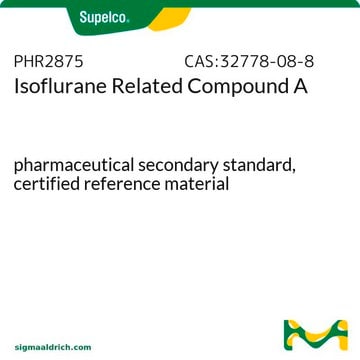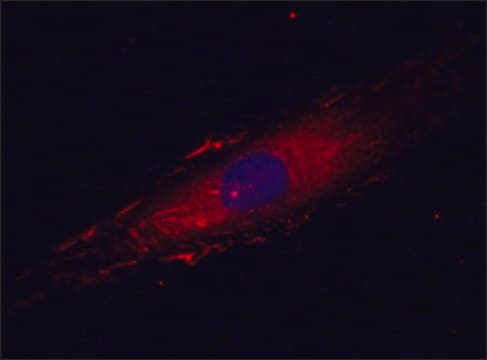402OA-05A
Human Chondrocytes - Osteoarthritis: HC-OA, adult
Synonym(s):
HC-OA cells
Sign Into View Organizational & Contract Pricing
All Photos(2)
About This Item
UNSPSC Code:
41106514
NACRES:
NA.81
Recommended Products
biological source
human articular cartilage (osteoarthritic)
Quality Level
packaging
pkg of 500,000 cells
manufacturer/tradename
Cell Applications, Inc
growth mode
Adherent
karyotype
2n = 46
morphology
chondrocyte
technique(s)
cell culture | mammalian: suitable
relevant disease(s)
arthritis
shipped in
dry ice
storage temp.
−196°C
General description
Lot specific orders are not able to be placed through the web. Contact your local sales rep for more details.
HC-OA Human Chondrocytes are derived from human articular cartilage of donors with osteoarthritis (OA). Osteoarthritis is an inflammatory disease characterized by increased degradation of cartilage tissue in the joint due to overproduction of enzymes degrading the extracellular matrix. Despite the initial proliferation and activation of chondrocytes, they are not able to efficiently repair the degrading cartilage. Instead, chondrocytes undergo terminal differentiation and eventually apoptose, leading to mineralization of cartilage in a process resembling bone formation during development. Thus, HC-OA provide a useful model to study changes in chondrocyte biology in response to abnormal environment of the OA joint.
Characterization: Positive for aggrecan after differentiation.
HC-OA have been used to demonstrate that THF-alpha activates transcription of ADAMTS-4, a metalloproteinase implicated in cartilage degradation in OA, via p38-MAPK-dependent mechanism (Xue, 2013).
HC-OA Human Chondrocytes are derived from human articular cartilage of donors with osteoarthritis (OA). Osteoarthritis is an inflammatory disease characterized by increased degradation of cartilage tissue in the joint due to overproduction of enzymes degrading the extracellular matrix. Despite the initial proliferation and activation of chondrocytes, they are not able to efficiently repair the degrading cartilage. Instead, chondrocytes undergo terminal differentiation and eventually apoptose, leading to mineralization of cartilage in a process resembling bone formation during development. Thus, HC-OA provide a useful model to study changes in chondrocyte biology in response to abnormal environment of the OA joint.
Characterization: Positive for aggrecan after differentiation.
HC-OA have been used to demonstrate that THF-alpha activates transcription of ADAMTS-4, a metalloproteinase implicated in cartilage degradation in OA, via p38-MAPK-dependent mechanism (Xue, 2013).
Cell Line Origin
Cartilage
Application
model for studying chondrocyte biology in an osteoarthritis joint
Components
Basal Medium containing 10% FBS & 10% DMSO
Preparation Note
- 1st passage, >500,000 cells in Basal Medium containing 10% FBS & 10% DMSO
- Can be cultured at least 10 doublings
Subculture Routine
Please refer to the HC-OA Culture Protocol.
Disclaimer
RESEARCH USE ONLY. This product is regulated in France when intended to be used for scientific purposes, including for import and export activities (Article L 1211-1 paragraph 2 of the Public Health Code). The purchaser (i.e. enduser) is required to obtain an import authorization from the France Ministry of Research referred in the Article L1245-5-1 II. of Public Health Code. By ordering this product, you are confirming that you have obtained the proper import authorization.
Storage Class Code
11 - Combustible Solids
WGK
WGK 3
Flash Point(F)
Not applicable
Flash Point(C)
Not applicable
Certificates of Analysis (COA)
Search for Certificates of Analysis (COA) by entering the products Lot/Batch Number. Lot and Batch Numbers can be found on a product’s label following the words ‘Lot’ or ‘Batch’.
Already Own This Product?
Find documentation for the products that you have recently purchased in the Document Library.
Quanzhi Liang et al.
BMC geriatrics, 21(1), 57-57 (2021-01-16)
Osteopontin plays critical roles in osteoarthritis (OA) by regulating the functions of osteoclasts. It is known that osteopontin can induce the expression of lncRNA HOX transcript antisense RNA (HOTAIR), indicating the involvement of HOTAIR in OA. This study was carried
Hongfei Zhang et al.
Clinical rheumatology, 39(11), 3473-3478 (2020-05-11)
LncRNA CTBP1-AS2 has been reported to be involved in type 2 diabetes and cardiomyocyte hypertrophy, while its roles in other human diseases are unknown. Our preliminary deep sequencing analysis showed altered expression of CTBP1-AS2 in osteoarthritis (OA). In addition, CTBP1-AS2
Xiangxiang Sun et al.
International journal of biological sciences, 16(6), 994-1009 (2020-03-07)
Osteoarthritis (OA) is a common type of arthritis. Chronic inflammation is an important contributor to the pathogenesis of OA. The maturation and secretion of proinflammatory cytokines are controlled by inflammasomes, especially NLRP1 (NLR Family Pyrin Domain Containing 1) and NLRP3.
Our team of scientists has experience in all areas of research including Life Science, Material Science, Chemical Synthesis, Chromatography, Analytical and many others.
Contact Technical Service







